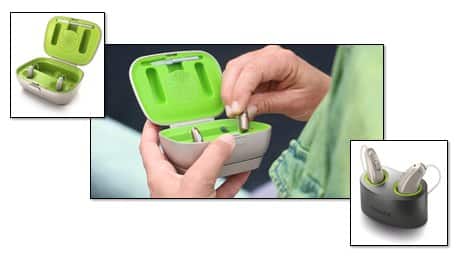Rechargeable Hearing Aids
Rechargeable hearing aids are a popular choice at HAB Hearing, the idea of rechargeable hearing aids generates a lot of interest with our clients. With rechargeable hearing aids you avoid the cost and fiddly nature of replacing your hearing aid batteries regularly.
How do rechargeable hearing aids work?
Rechargeable hearing aids mostly have an internal battery, a little like most modern mobile phones. With a rechargeable battery fully integrated into the hearing aid you have no option to change the battery yourself, you simply pop the hearing aid into its charger at night and it is ready to go the next day. You can if you wish top up the charge during the day but you should not need to do that if charged overnight.
Pros and cons of rechargeable hearing aids
Rechargeable hearing aids potentially offer extra reliability. As a sealed unit there is a reduced chance of things going wrong with your hearing aids. Issues that might arise around moisture ingress, contact issues etc. can be avoided.
Rechargeable hearing aid batteries will typically need replacing at 5-6 years, which happens to be a typical lifespan of hearing aids. (Clients tend to upgrade their hearing aids around this timescale for all sorts of reasons).
Where clients do request a replacement of the internal rechargeable batteries in hearing aids we do not anticipate the cost of replacement will be excessive in comparison to the original cost of the hearing aids.
 A hearing aid case and charger combined
A hearing aid case and charger combined
With rechargeable hearing aids they are supplied with some kind of charging case or charging pod. Some charging stations are designed to be pocket size for portability. Others a little more substantial and with battery packs. These last you a few days if away with little option to access power.
Some charging cases also allow enough room for drying capsules. Some manufacturers also supply a mini charger for travelling or a more substantial case that allows for multiple charges.
Overnight and quick charging
Rechargeable hearing aids can be charged overnight or when it’s convenient for you. It can become part of a daily routine meaning you should find yourself less unlikely to run out of power from your hearing aid inconveniently. Typically you would charge overnight to last all the following day but have the option for a quick charge to last a few hours if necessary.
Are all rechargeable hearing aids ‘behind the ear’?
Actually not the case. Most rechargeable hearing aids at the moment are to be fair, but Starkey in particular offer a really nice ‘in the ear’ rechargeable hearing aid that also streams wirelessly to both Apple and Android phones.
Starkey have a good reputation for building neat ‘in the ear’ hearing aids, although this type of technology is not available as a completely discreet ‘completely in canal’ version.
The Starkey Livio custom rechargeable ITC hearing aid has a number of extra nice touches too. Magnetic, so it is really easy to handle and put on charge in it’s charging station, no fiddly batteries of course, so overall a great option for those with limited dexterity. Also tap control, a fall detection feature and a health app built in!
Good for the environment?
Rechargeable hearing aids as an option are more eco friendly than zinc air hearing aid batteries. Nowadays, hearing aid batteries are mercury free (they used to contain a small amount of mercury). There is still more of an environmental impact with disposable hearing aid batteries.
What is the cost implication with rechargeable hearing aids?
Typically the cost of rechargeable hearing aids is a little higher than the equivalent hearing aid that uses a standard disposable zinc air hearing aid battery. The extra cost of buying rechargeable hearing aids can to a degree be offset by the savings of not buying disposable zinc air hearing aid batteries.
If you work out the sums a box of 60 hearing aid batteries is just under £13 on our website here. So a typical size 312 hearing aid battery might last a week. As a rough rule of thumb you might spend £13 a year per ear on batteries. With a more severe hearing loss you consume more batteries. If the hours a day you wear your hearing aids is longer you’ll get less days before they run out! The larger size 13 batteries last much longer than the smallest size 10 batteries!
Putting aside the ‘how long is a piece of string’ argument it’s probably cheaper to use disposable hearing aid batteries. However, many people like the convenience and environmental benefits of using rechargeable hearing aids.
If you are interested in rechargeable hearing aids…
Rechargeable hearing aids tend to cost slightly more than the equivalent non rechargeable hearing aids at any particular technology level or manufacturer. Some might say it is a price worth paying.
This format is definitely an attractive option from a convenience point of view or if you are interested in the environmental aspect. Most rechargeable hearing aids from the major UK manufacturers at this point are available in RIC and BTE format (the type of hearing aid that sits on the back of your ear), although we are starting to see ‘in the ear’ rechargeable hearing aids becoming available.
If you’d like to know the prices of the various models here are our hearing aid prices. If you’d like to find out more just contact us. We’d love to hear from you!

